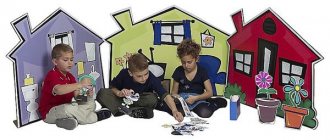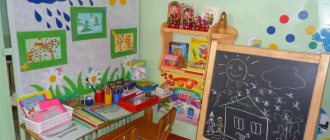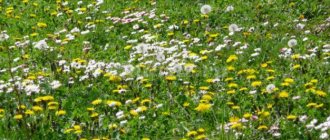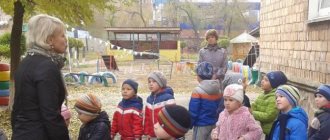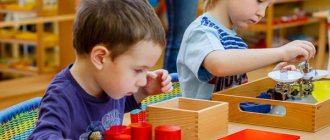A walk to the preschool educational institution. Kinds
The importance of walking for the health of preschool children
Author: Burobina Nina Valerievna, senior teacher of the preschool educational institution “Kindergarten No. 4” in the city of Mikhailov. A child’s systematic active stay in the fresh air is one of the main factors in full physical development. A walk of any direction is also effective as an accessible way to harden a fragile child’s body, helps build resistance to colds, and improves immunity. The main activities of preschoolers during a walk are outdoor games, which have a beneficial effect on the development of the circulatory, respiratory, musculoskeletal systems, and improves appetite. Using those located on the playground, children, during independent play activities, learn to overcome obstacles, coordinate movements, and develop the vestibular apparatus. Children acquire new skills, motor skills, become brave, dexterous, and resilient. In addition, during a walk, the child naturally learns about the world around him and gains new knowledge.
Basic requirements for the duration of a walk in kindergarten
In optimal weather conditions, the walk is carried out twice a day. The first trip outside takes place immediately after classes, the second - after afternoon tea. The teacher regulates the duration of the walk in accordance with climatic conditions, the total walk time recommended by sanitary standards is 4 hours. At air temperatures below -15 and wind speeds of more than 7 m/s, the walk time is reduced. Winds of more than 15 m/s, precipitation, and extremely low air temperatures are grounds for prohibiting going out for a walk. During the summer healing period, it is recommended to use any opportunities for walks in the fresh air; stay in the group room is limited to sleep and meals. The time for going out for a walk is determined by teachers independently, in accordance with the regime of the educational process for children of different age groups.
Depending on the location, walks are divided into several types:
1. Walks on the territory of the preschool educational institution. 2. Walking outside the perimeter of the institution. 3. Walks in the functional premises of the kindergarten (canopies, verandas), in bad weather.
According to their focus, walks have the following categories:
1) traditional; 2) targeted (with going beyond the subsidiaries); 3) thematic; 4) excursion.
Features of a targeted walk
Organizing a targeted walk requires the teacher to have certain organizational skills and spend time preparing and completing documentation. Exit outside the kindergarten is not carried out without the consent of parents, approval of the route by the administration at the request of the leader of the walk, indicating the number of pupils accompanying. The developmental significance of going beyond limits for very young children is great. Under the strict guidance of a mentor, they observe natural phenomena and social life. Active walking builds endurance and has a beneficial effect on physical development. It is recommended that children of the younger group be taken outside near the preschool educational institution once a week. The teacher shows them houses, transport, people on foot. For children in the middle group, the purpose of public buildings is explained: schools, recreation centers, hospitals. The older children are taken for long walks around the locality where the kindergarten is located twice a week. Walks to neighboring streets and parks introduce children to the rules of behavior in public places, the peculiarities of traffic and pedestrians. Targeted walks help broaden the pupils' horizons, develop curiosity and observation. Children's knowledge and ideas about the world around them are deepened on the basis of empirical, direct perception; they are not imposed from above and do not cause protest, which is very valuable in the sense of preserving the special psychological world of a preschool child.
Structural parts of a walk in a preschool educational institution:
1. Observation.
2. Outdoor games. 3. Individual work of the teacher with children. 4. Children's labor on the site. 5. Independent play activity. The components of the walk can vary depending on the mood of the children, weather conditions, and the nature of previous activities. Each type of activity lasts 7-15 minutes, and then is replaced by another against the backdrop of independent activity of the students. It is prohibited: 1. Leaving children alone, unattended by employees of the Institution. 2. Use sharp, piercing, cutting objects and broken toys in children's games.
We recommend watching:
Organization of walks in the preparatory group. Walks in the summer with older preschoolers. Consultations for teachers. Organization of walks - hikes with preschoolers in nature. Themed walks in kindergarten. Middle group
Similar articles:
Organization of a walk in the junior group according to the Federal State Educational Standard
Observations of wildlife in the younger group of kindergarten
Observations of inanimate nature on a walk in the younger group
Observations of the work of adults in the younger group
Observations of street life. Junior group
“The importance of a walk in kindergarten” article on the topic
Structural unit “Kindergarten “18 combined type”
MBDOU "Kindergarten "Rainbow" combined type"
Ruzaevsky municipal district
Speech at the teachers' meeting
"The importance of walking in kindergarten"
1. The importance of walking as a means of education.
Children's stay in the fresh air is of great importance for the physical development of a preschooler. Walking is the first and most accessible means of hardening a child’s body. It helps to increase its endurance and resistance to adverse environmental influences, especially colds.
During the walk, children play and move a lot. Movement increases metabolism, blood circulation, gas exchange, and improves appetite. Children learn to overcome various obstacles, become more agile, dexterous, courageous, and resilient. They develop motor skills and abilities, strengthen the muscular system, and increase vitality.
Walking promotes mental education. While staying on the site or on the street, children receive many new impressions and knowledge about their surroundings: about the work of adults, about transport, about traffic rules, etc. From observations, they learn about the features of seasonal changes in nature, notice connections between various phenomena, and establish elementary dependencies. Observations arouse their interest and a number of questions to which they strive to find an answer. All this develops observation, expands ideas about the environment, awakens the thoughts and imagination of children.
Walks provide an opportunity to solve problems of moral education. The teacher introduces the children to their hometown, its sights, and the efforts of the adults who landscape its streets, build beautiful houses, and pave roads. At the same time, the collective nature of work and its importance are emphasized: everything is done to ensure that our people live comfortably, beautifully and joyfully. Familiarization with the surrounding environment helps to instill in children a love for their hometown. The kids are working in the flower garden - planting flowers, watering them, loosening the ground. They are taught hard work, love and respect for nature. They learn to notice its beauty. The abundance of colors, shapes, sounds in nature, their combination, repetition and variability, rhythm and dynamics - all this causes joyful experiences even in the smallest ones.
Thus, properly organized and thoughtful walks help to achieve the goals of the comprehensive development of children. Children are allowed to spend up to four hours a day outdoors. In summer this time increases significantly. The daily routine of the kindergarten includes a daytime walk after classes and an evening walk.
2. Kindergarten site and its equipment.
To carry out the tasks of comprehensive development, an area is being created on the territory of the kindergarten to organize a variety of activities for children. A landscaped area, planned and equipped in accordance with pedagogical and hygienic requirements, is of great importance. It is desirable that each age group has a separate area, fenced off from other groups by bushes. In this area, places are allocated for outdoor games and the development of children’s movements (flat area), for games with sand, water, building materials, for creative games and games with various toys.
The area should have equipment for developing movements: climbing fences (triangular, tetrahedral and hexagonal), a balance beam, a slide, equipment for jumping and throwing exercises. All this should have an attractive appearance, be durable, well processed, secured and suitable for the age and strength of the children. In addition to permanent equipment, toys and aids are brought to the site in accordance with the planned work plan. Playgrounds end with paths along which children can ride bicycles and cars.
In addition to playgrounds, the site must have closed gazebos for protection from rain and sun.
In winter, a slide, ice paths and snow structures, and a skating rink (if conditions permit) should be installed on the site.
3. Preparing children for a walk.
To ensure that children are willing to go for a walk, the teacher thinks through the contents of the walk in advance and arouses the children’s interest in it with the help of toys or a story about what they will be doing. If walks are meaningful and interesting, children, as a rule, go for walks with great desire.
Dressing children should be organized so as not to waste a lot of time and so that they do not have to wait for each other for a long time. To do this, it is necessary to think through and create appropriate conditions. Each group needs a spacious dressing room with individual lockers and a sufficient number of banquettes and chairs so that the child can sit comfortably, put on leggings or shoes and not disturb other children.
The teacher must teach children to dress and undress independently and in a certain sequence. First, they all put on leggings, shoes, then a scarf, coat, hat, scarf and mittens. When returning from a walk, undress in the reverse order. The nanny helps dress the kids, but gives them the opportunity to do what they can on their own. When children develop dressing skills and... undressing and they will do it quickly and carefully, the teacher only helps them in individual cases (fasten a button, tie a scarf, etc.). We need to teach kids to help each other and not forget to thank each other for the service rendered. In order for dressing and undressing skills to develop faster, parents should provide their children with more independence at home.
When most of the children are dressed, the teacher goes out with them to the site. The nanny watches the rest of the children and then escorts them to the teacher. When going for a walk, children themselves bring out toys and materials for games and outdoor activities.
4. Contents of children’s activities during a walk.
Keeping children out for a walk depends on the time of year, weather, previous activities, interests and age.
The leading place during the walk is given to games, mainly active ones. They develop basic movements, relieve mental stress from classes, and develop moral qualities. An outdoor game can be played at the beginning of a walk if the activities involved children sitting for a long time. If they go for a walk after a music or physical education lesson, then the game can be played in the middle of the walk or half an hour before it ends.
The choice of game depends on the time of year, weather, air temperature. On cold days, it is advisable to start your walk with games of greater mobility associated with running, throwing, and jumping. Fun and exciting games help children cope better with cold weather. In damp, rainy weather (especially in spring and autumn), sedentary games that do not require a lot of space should be organized.
Games with jumping, running, throwing, and balance exercises should also be carried out on warm spring, summer days and early autumn.
During walks, plotless folk games with objects, such as grandmothers, ring throws, skittles, can be widely used, and in older groups - elements of sports games: volleyball, basketball, gorodki, badminton, table tennis, football, hockey. In hot weather, water games are held.
Games are useful, with the help of which children’s knowledge and ideas about the environment expand. The teacher gives the children cubes, lotto, encourages games of family, astronauts, steamship, hospital, etc. He helps develop the plot of the game, select or create the necessary material for it.
In addition to outdoor games and individual exercises in basic movements, sports entertainment - exercises - are also organized during the walk. In the summer this means cycling, swimming (if there is a pool or pond), in the winter - sledding, ice skating, sliding on ice paths, and skiing.
During the walk, it is necessary to pay attention to the work activities of children. The content and forms of its organization depend on the weather and time of year. So, in the fall, children collect flower seeds and harvests from the garden; in winter, they can rake snow and make various structures out of it. It is necessary to strive to make child labor joyful, helping children to master useful skills and abilities.
Labor tasks should be within the capabilities of children and at the same time require some effort from them. The teacher makes sure that they do their work well and finish what they started.
A large part of the walks is devoted to observations (pre-planned) of natural phenomena and social life. Observations can be carried out with a whole group of children, with subgroups, as well as with individual children. The teacher attracts some to observations in order to develop attention, while others arouse interest in nature or social phenomena, etc.
The surrounding life and nature provide an opportunity to organize interesting and varied observations. For example, you can pay attention to the clouds, their shape, color, and compare them with images known to children. Observations of the work of adults who work near the kindergarten, for example construction workers, should also be organized.
During the walk, the teacher makes sure that all the children are busy, not bored, and that no one gets cold or overheated. It attracts those children who run a lot to participate in quieter games.
About half an hour before the end of the walk, the teacher organizes quiet games. Then the children collect toys and equipment. Before entering the room, they wipe their feet. Children undress quietly, without noise, carefully fold and put things in lockers. They put on slippers, put their suit and hair in order and go to the group.
5. Targeted walks and their meaning.
The teacher organizes children’s observations of and their significance in social life and natural phenomena and outside the site. For this purpose, targeted walks are organized.
In the younger group, targeted walks are carried out once a week over a short distance, along the street where the kindergarten is located. With older children, such walks are carried out twice a week and over longer distances.
For children of the younger group, the teacher shows houses, transport, pedestrians, for the middle group - public buildings (school, House of Culture, theater, etc.). With older children, targeted walks are carried out to other streets, to the nearest park or forest. Children become familiar with the rules of behavior in public places and traffic rules.
On targeted walks, children receive many direct impressions of their surroundings, their horizons expand, their knowledge and understanding deepen, and their powers of observation and curiosity develop. Movement in the air has a positive effect on physical development. Walking for a long time during a walk requires children to have a certain amount of endurance, organization and endurance.
During walks, the teacher conducts individual work with children: for some, he organizes a game with a ball, throwing at a target, for others - a balance exercise, for others - jumping from tree stumps, stepping over trees, running down hills.
During walks, work is also done to develop the child’s speech: learning a nursery rhyme or a short poem, reinforcing a difficult sound to pronounce, etc. The teacher can recall with the children the words and melody of a song that they learned in a music lesson.
In 24-hour preschools, children also have an evening walk. The area should be well lit. The main place during the walk is given to children's independent games.
6.Organization and methodology of the walk.
Children's stay in the fresh air is of great importance for physical development. Walking is the first and most accessible means of hardening a child’s body. It helps to increase its endurance and resistance to adverse environmental influences, especially colds. During the walk, children play and move a lot. Movement increases metabolism, blood circulation, gas exchange, and improves appetite. Children learn to overcome various obstacles, become more agile, dexterous, courageous, and resilient. They develop motor skills and abilities, strengthen the muscular system, and increase vitality.
Walking promotes mental education. While staying on the site or on the street, children receive many new impressions and knowledge about their surroundings: about the work of adults, about transport, about traffic rules, etc. From observations, they learn about the features of seasonal changes in nature, notice connections between various phenomena , establish an elementary dependency. Observations arouse their interest and a number of questions to which they strive to find an answer. All this develops observation, expands ideas about the environment, awakens the thoughts and imagination of children.
Walks provide an opportunity to solve problems of moral education. The teacher introduces the children to their hometown, its sights, and the efforts of the adults who landscape its streets, build beautiful houses, and pave roads. At the same time, the collective nature of work and its importance are emphasized: everything is done to ensure that our people live comfortably, beautifully and joyfully. Familiarization with the surrounding environment helps to instill in children a love for their hometown. The kids are working in the flower garden - planting flowers, watering them, loosening the soil. They are taught hard work, love and respect for nature. They learn to notice its beauty. The abundance of colors, shapes, sounds in nature, their combination, repetition and variability, rhythm and dynamics - all this causes joyful experiences even in the smallest ones.
Thus, properly organized and thoughtful walks help to achieve the goals of the comprehensive development of children. Children are allowed to spend up to four hours a day outdoors. In summer this time increases significantly. The daily routine of the kindergarten includes a daytime walk after classes and an evening walk after afternoon tea. The time allotted for walking must be strictly observed.
For the implementation of the tasks of comprehensive development and organization of various activities of children, a landscaped area, planned and equipped in accordance with pedagogical and hygienic requirements, is of great importance. It is desirable that each age group has a separate area, fenced off from other groups by bushes. In this area, places are allocated for outdoor games and the development of children’s movements (flat area), for games with sand, water, building materials, for creative games and games with various toys. The area should have equipment for developing movements: climbing fences (triangular, tetrahedral and hexagonal), a balance beam, a slide, equipment for jumping and throwing exercises. All this should have an attractive appearance, be durable, well processed, secured and suitable for the age and strength of the children. In addition to permanent equipment, toys and aids are brought to the site in accordance with the planned work plan. Playgrounds end with paths along which children can ride bicycles and cars.
In addition to playgrounds, the site must have closed gazebos for protection from rain and sun.
In winter, a slide, ice paths and snow structures, and a skating rink (if conditions permit) should be installed on the site.
To ensure that children are willing to go for a walk, the teacher thinks through its content in advance and arouses children’s interest in it with the help of toys or a story about what they will be doing. If walks are meaningful and interesting, children, as a rule, go for walks with great desire.
Dressing children should be organized so as not to waste a lot of time and so that they do not have to wait for each other for a long time. To do this, it is necessary to think through and create appropriate conditions. Each group needs a spacious dressing room with individual lockers and a sufficient number of banquettes and chairs so that the child can sit comfortably, put on leggings or shoes and not disturb other children. The teacher must teach children to dress and undress independently and in a certain sequence. First, they all put on leggings, shoes, then a scarf, coat, hat, scarf and mittens. When returning from a walk, undress in the reverse order. The nanny helps dress the kids, but gives them the opportunity to do what they can on their own. When children develop the skills of dressing and undressing and they do it quickly and accurately, the teacher only helps them in individual cases (fasten a button, tie a scarf, etc.). We need to teach kids to help each other and not forget to thank each other for the service rendered. In order for dressing and undressing skills to develop faster, parents should provide their children with more independence at home.
When most of the children are dressed, the teacher goes out with them to the site. The nanny watches the rest of the children and then escorts them to the teacher. When going for a walk, children themselves bring out toys and materials for games and outdoor activities. Planning the content of children's activities during a walk depends on the time of year, weather, previous activities, interests and age.
The leading place during the walk is given to games, mainly active ones. They develop basic movements, relieve mental stress from classes, and develop moral qualities. An outdoor game can be played at the beginning of a walk if the activities involved children sitting for a long time. If they go for a walk after a music or physical education lesson, then the game can be played in the middle of the walk or half an hour before it ends.
The choice of game depends on the time of year, weather, air temperature. On cold days, it is advisable to start your walk with games of greater mobility associated with running, throwing, and jumping. Fun and exciting games help children cope better with cold weather. In damp, rainy weather (especially in spring and autumn), sedentary games that do not require a lot of space should be organized. Games with jumping, running, throwing, and balance exercises should also be carried out on warm spring, summer days and early autumn.
During walks, plotless folk games with objects, such as babki, serso, ring throw, skittles, can be widely used, and in older groups - elements of sports games: volleyball, basketball, gorodki, badminton, table tennis, football, hockey. In hot weather, water games are held.
Games are useful, with the help of which children’s knowledge and ideas about the environment expand. The teacher gives the children cubes, lotto, encourages games of family, astronauts, steamship, hospital, etc. He helps develop the plot of the game, select or create the necessary material for it.
In addition to outdoor games and individual exercises in basic movements, sports activities (exercises) are also organized during the walk. In the summer, this includes cycling, swimming (if there is a pool or pond), in the winter, sledding, skating, sliding on ice paths, and skiing. During the walk, it is necessary to pay attention to the work activities of children. The content and forms of its organization depend on the weather and time of year. So, in the fall, children collect flower seeds and harvests from the garden; in winter, they can rake snow and make various structures out of it. It is necessary to strive to make child labor joyful, helping children to master useful skills and abilities.
Labor tasks should be within the capabilities of children and at the same time require some effort from them. The teacher makes sure that they do their work well and finish what they started.
A large part of the walks is devoted to observations (pre-planned) of natural phenomena and social life. Observations can be carried out with a whole group of children, with subgroups, as well as with individual children. The teacher attracts some to observations in order to develop attention, while others arouse interest in nature or social phenomena, etc.
The surrounding life and nature provide an opportunity to organize interesting and varied observations. For example, you can pay attention to the clouds, their shape, color, and compare them with images known to children. Observations of the work of adults who work near the kindergarten, for example construction workers, should also be organized. During the walk, the teacher makes sure that all the children are busy, not bored, and that no one gets cold or overheated. It attracts those children who run a lot to participate in quieter games.
About half an hour before the end of the walk, the teacher organizes quiet games. Then the children collect toys and equipment. Before entering the room, they wipe their feet. Children undress quietly, without noise, carefully fold and put things in lockers. They put on slippers, put their suit and hair in order and go to the group. The teacher organizes children’s observations of social life and natural phenomena outside the site. For this purpose, targeted walks are organized. In the younger group, targeted walks are carried out once a week over a short distance, along the street where the kindergarten is located. With older children, such walks are carried out twice a week and over longer distances.
For children of the younger group, the teacher shows houses, transport, pedestrians, for the middle group - public buildings (school, House of Culture, theater, etc.) With older children, targeted walks are carried out to other streets, to the nearest park or forest. Children become familiar with the rules of behavior in public places and traffic rules. On targeted walks, children receive many direct impressions of their surroundings, their horizons expand, their knowledge and understanding deepen, and their powers of observation and curiosity develop. Movement in the air has a positive effect on physical development. Walking for a long time during a walk requires children to have a certain amount of endurance, organization and endurance.
During walks, the teacher conducts individual work with children: for some, he organizes a game with a ball, throwing at a target, for others - a balance exercise, for others - jumping from tree stumps, stepping over trees, running down hills. During walks, work is also done to develop the child’s speech: learning a nursery rhyme or a short poem, reinforcing a difficult sound to pronounce, etc. The teacher can recall with the children the words and melody of a song that they learned in a music lesson.
In 24-hour preschools, children also have an evening walk. The area should be well lit. The main place during the walk is given to children's independent games.
7. Rules for walks in kindergarten.
The daily duration of children's walks is at least 4-4.5 hours. The walk is organized 2 times a day: in the first half - before lunch and in the second half of the day - after a nap or before the children go home. When the air temperature is below -15 degrees C and the wind speed is more than 7 m/s, the duration of the walk is reduced. The walk is not carried out at an air temperature below -15 degrees C and a wind speed of more than 15 m/s for children under 4 years old, and for children 5-7 years old at an air temperature below -20 degrees C and a wind speed of more than 15 m/s.
SanPiN 2.4.1.1249-03 clause 2.12.2
“The role of walking in the health of preschool children.”
author: Fomenko Vera Anatolyevna
teacher of MKDOU “Yolochka”, Sedanovo village, Ust-Ilimsky district
“The role of walking in the health of preschool children.”
Municipal state preschool educational institution general developmental kindergarten “Yelochka”
“The role of walking in the health of preschool children.”
Prepared by:
teacher Fomenko V.A.
Sedanovo village, Ust-Ilimsky district
Raising a healthy child is one of the most important tasks of a family and a preschool educational institution. What is health? Health is a multifaceted, multi-level concept. According to the Constitution of the World Health Organization, health means “a state of complete physical, mental and social well-being and not merely the absence of disease or infirmity.” Thus, health includes physical, mental and moral components, that is, health is a system of moral values and a set of personal qualities of a person that provide him with a full existence and the fulfillment of his biological and social functions. According to research by experts, 75% of adult diseases originate in childhood. Only 10% of children come to school completely healthy. Research shows that modern children, for the most part, experience a “motor deficit” - physical inactivity, that is, the number of movements they perform during the day is below the age norm. Thus, the intensity of children’s physical development and their health depends on physical activity.
Therefore, the more the child moves, the more successfully the entire complex process of biological formation of the body occurs. Every year there is an increasingly high level of somatic diseases in children, a tendency towards general weakening of children entering kindergarten, and a decrease in immunity. Therefore, one of the urgent problems is the organization of physical activity during the day.
One of the main tasks that the Program sets for educators is to take care of preserving and strengthening the health of children, developing in them basic ideas about a healthy lifestyle, developing healthy habits, including healthy eating habits, and the need for physical activity.
In our kindergarten, great attention is paid to the proper organization of walks in the preschooler’s daily routine. Children's stay in the fresh air is of great importance for the physical development of a preschooler. Walking is the first and most accessible means of hardening a child’s body. It helps to increase its endurance and resistance to adverse environmental influences, especially colds. Our kindergarten students play a lot and move around during walks. Movement increases metabolism, blood circulation, gas exchange, and improves appetite. Children learn to overcome various obstacles, become more agile, dexterous, courageous, and resilient. They develop motor skills and abilities, strengthen the muscular system, and increase vitality.
To implement health-improving tasks, areas for organizing a variety of children’s activities have been created on the territory of our kindergarten. They are landscaped, planned and equipped in accordance with pedagogical and hygienic requirements. Each age group has a separate area. In all areas, places are allocated for outdoor games and the development of children’s movements (flat area, for playing with sand, water, building materials, for creative games and games with various toys.
In addition to playgrounds, the plots have covered verandas for protection from rain and sun, which makes it possible to spend time outside in any weather.
In the winter, together with the children, we build slides, ice paths and snow structures, and labyrinths.
We organize games together, mostly outdoor ones. They develop basic movements, relieve mental stress from classes, and develop moral qualities. We conduct outdoor play at the beginning of the walk if the activities involved children sitting for a long time. If children go for a walk after a music or physical education lesson, then we play the game in the middle of the walk or half an hour before it ends.
The choice of game depends on the time of year, weather, air temperature. On cold days, we begin our walk with games of greater mobility associated with running, throwing, and jumping. Fun and exciting games help children cope better with cold weather. In damp, rainy weather (especially in spring and autumn), we organize sedentary games that do not require a large space.
Games with jumping, running, throwing, and balance exercises are held on warm spring, summer days and early autumn.
During our walks, we widely use plotless folk games with objects, such as ring toss and skittles.
In addition to outdoor games, we carry out breathing exercises in the fresh air, in the warm season, water and air procedures, walking barefoot on sand and corrective mats. Sports activities are also organized during the walk. In the summer it’s cycling, in the winter it’s sledding, sliding on icy paths, and skiing.
During walks, we work individually with children: for some we organize games with a ball, throwing at a target, for others - balance exercises, for others - jumping off stumps, stepping over gymnastic sticks, running down hills.
During the walk, we make sure that all the children are busy, do not get bored, and that no one gets cold or overheated. We encourage those children who run a lot to participate in quieter games.
Games are useful, with the help of which children’s knowledge and ideas about the environment expand. We give children cubes, lotto, and encourage them to play family, bus, ship, hospital, etc. We help develop the plot of the game, select or create the necessary material for it.
We devote a lot of space to observations. While staying on the site or on the street, children receive many new impressions and knowledge about their surroundings.
We organize children’s observations of social life and natural phenomena outside the site. For this purpose, targeted walks, trips to the park and forest are organized.
During the summer health period, we try to conduct all classes and activities in the fresh air: receiving children on a walking site, morning exercises, physical education and music classes, artistic creativity, conversations, etc.
On targeted walks, children receive many direct impressions of their surroundings, their horizons expand, their knowledge and understanding deepen, and their powers of observation and curiosity develop. Movement in the air has a positive effect on physical development. Walking for a long time during a walk requires children to have a certain amount of endurance, organization and endurance.
During the walk, we pay attention to the children’s work activities. The content and forms of its organization depend on the weather and time of year. So, in the fall, children collect flower seeds and transfer sand to the sandbox; In winter they can shovel snow and make various structures out of it.
Issues of raising a healthy child should be resolved in close contact with the family. In kindergarten we offer consultations to parents: “The role of walking for the health of a preschool child”, “Let's play on a walk with our daughter and son”, reminders. Parents are frequent visitors to the site, in the fresh air. Together with their parents, children go on targeted hikes, excursions, engage in physical education with children and general developmental exercises, basic types of movement, and conduct joint relay races, games, and entertainment.
All these components allow you to make your walk more eventful and interesting. In addition, they act not as separate pedagogical events, but as logically justified parts of the main thing that is planned by adults in a particular outing. The main thing is that each of the components of the walk contributes its own, unique contribution to the health, development and education of preschool children.
LIST OF REFERENCES USED:
- Veraksa N. E., Komarova T. S., Vasilyeva M. A. “From birth to school. Approximate basic general education program for preschool education”/ /Ed.—2nd ed., and additional. \M.:MOSAIKA-SYNTHESIS, 2012.
- Kiseleva G. M., Ponomareva L. I. “Walks in kindergarten. Junior and middle groups” // Methodological manual / Ed. - M.: TC Sfera, 2009
- Korneicheva E. E., Gracheva N. I. “Planning extracurricular activities with children during the day” // Educational manual. – M.: Center for Pedagogical Education, 2011.
“The role of walking in the health of preschool children.”
How exactly are walks beneficial for children?
First of all, let's remember the main advantages of this process.
How exactly are walks beneficial for children in general and preschoolers in particular?
Several points can be highlighted, namely:
- Walking improves your health. The child breathes fresh air, moves and spends time actively. All this has a beneficial effect on his overall well-being.
- prevention of fatigue. The more often and regularly the baby walks, the more resilient he becomes. Regular walks help your child get tired less often and not get tired.
- metabolism improves. The more a child breathes fresh air, the better his metabolism will be. Walking improves nutrient absorption.
- The child's body is being hardened . Regular walks, especially in not the best weather, strengthen the child. But here it is important not to overdo it and dress according to the weather.
- the child catches colds less often. Regular walking increases your child's stamina and resistance to colds.
So, as you can see, there are many reasons for regular walks. But there are some other important nuances associated with negative emotions. Let's look at this topic in more detail and separately!
How are negative emotions and walking related?
If the walk is well and correctly organized, if it is of sufficient duration, children realize about 50% of the daily need for active movements in it.
⠀
Stanford University conducted research that proved that an hour and a half walk in nature reduces the activity of the area of the brain that is responsible for negative emotions.
Therefore, with regular walks, the child feels better. He is calmer and more reasonable.
During a walk, the child learns about the world around him, learns to communicate with peers, make new discoveries, have fun and be himself.
We wrote in more detail about how walks in kindergarten should be carried out correctly on our website. Look! ⠀ We at RigaKids really love our atmospheric walks! We invite you too. Negative emotions do not linger in the kindergartens of the RigaKids network, because we have a beautiful garden and regular walks.
⠀
